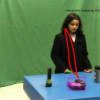Free Online Productivity Tools
i2Speak
i2Symbol
i2OCR
iTex2Img
iWeb2Print
iWeb2Shot
i2Type
iPdf2Split
iPdf2Merge
i2Bopomofo
i2Arabic
i2Style
i2Image
i2PDF
iLatex2Rtf
Sci2ools
CVPR
2007
IEEE
2007
IEEE
Objects in Action: An Approach for Combining Action Understanding and Object Perception
Analysis of videos of human-object interactions involves understanding human movements, locating and recognizing objects and observing the effects of human movements on those objects. While each of these can be conducted independently, recognition improves when interactions between these elements are considered. Motivated by psychological studies of human perception, we present a Bayesian approach which unifies the inference processes involved in object classification and localization, action understanding and perception of object reaction. Traditional approaches for object classification and action understanding have relied on shape features and movement analysis respectively. By placing object classification and localization in a video interpretation framework, we can localize and classify objects which are either hard to localize due to clutter or hard to recognize due to lack of discriminative features. Similarly, by applying context on human movements from the objects on which th...
Action Understanding | Computer Vision | CVPR 2007 | Human Movements | Human Perception | Object Classification | Object Reaction |
Related Content
| Added | 12 Oct 2009 |
| Updated | 28 Oct 2009 |
| Type | Conference |
| Year | 2007 |
| Where | CVPR |
| Authors | Abhinav Gupta, Larry S. Davis |
Comments (0)

